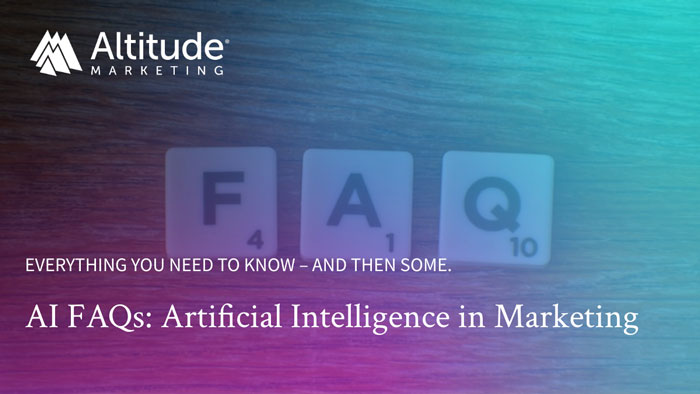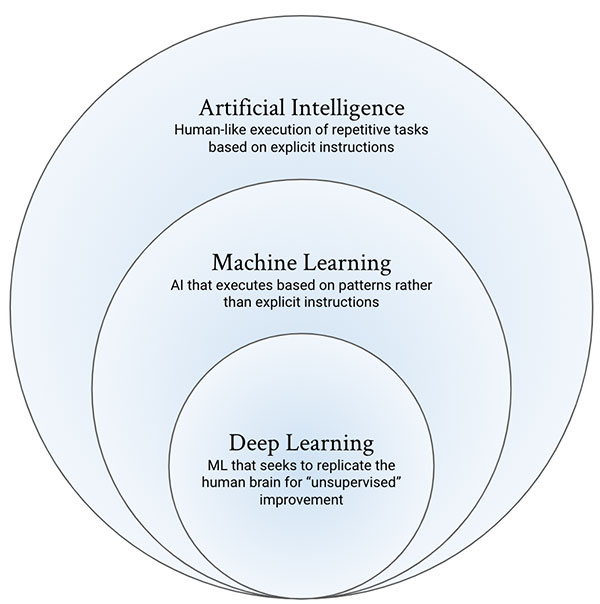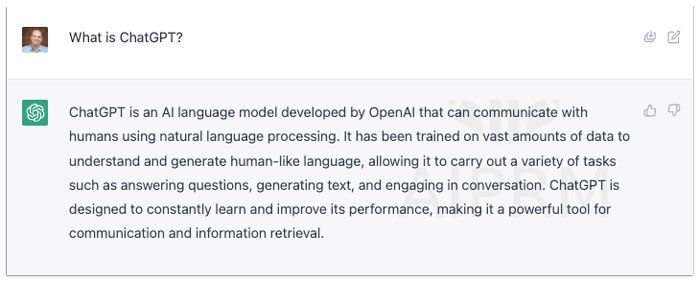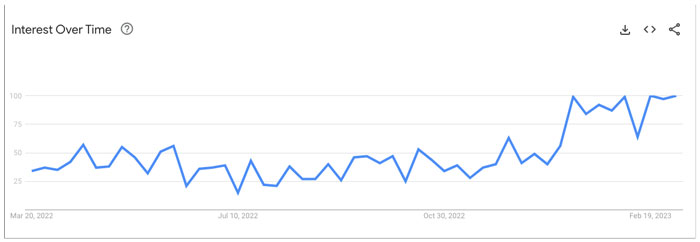If you’re a marketer, there’s a very good chance you’ve been thinking about AI in recent months. The tech isn’t new, but the rise of ChatGPT and Midjourney has created unprecedented buzz around the topic.
That rise – coupled with a general lack of understanding about AI – has created endless questions. How does AI marketing work? Is AI marketing legit? Will AI take your marketing job? Are the robots taking over? In this post, we’ll break down those and other topics, with eyes on giving marketers the understanding they need to put artificial intelligence to work for them.
Whether you’re just getting started with AI in marketing or looking to deepen your understanding, this post will provide insights and answers about this exciting and rapidly evolving field.

AI in Marketing: Frequently Asked Questions
In very short, “AI” is short for “artificial intelligence.” Per the OED, AI is defined as “the capacity of computers or other machines to exhibit or simulate intelligent behaviour; the field of study concerned with this.”
When it comes to AI in marketing, that definition is a bit broad. For our purposes, it’s best to say that AI is the ability of virtual machines to deliver human-like work product in response to repetitive tasks.
This definition of AI in marketing encompasses varying levels of complexity. These can be broken down broadly into traditional AI, machine learning and deep learning. Each of these is a subset of the prior, like so:
“AI” in the broadest sense is the basic ability for a machine to follow directions and deliver work product. Examples of AI include round-robin routing of website leads, data enrichment for CRM records, and automated email follow-ups. Basically, any “workflow” associated with marketing automation can and should be considered AI.
Within AI is machine learning. In broad strokes, this refers to a machine’s ability to identify patterns in data it’s given, and execute tasks accordingly. Whereas “traditional” AI requires explicit instructions (e.g., send an email to the address specified), machine learning allows for some degree of autonomy (e.g., analyze this traffic data, and predict the next three months’ results). Excel’s FORECAST capabilities are a good example of machine learning for marketing.
Finally, there’s deep learning – a subset of machine learning. The line between the two disciplines is blurry, but the upshot is that deep learning typically relies on “neural networks” – sets of algorithms designed to replicate the human brain. This allows for more free-form inputs (e.g., data lakes rather than spreadsheets), and more complex or free-form analysis. In essence, a deep learning model should be able to “train” itself, rather than simply answering a question based on what it’s given.
Marketing is full of repetitive tasks that AI can help with. For example, simply getting a lead into a CRM from a web form involves at least two tasks, and usually more. Without any AI assistance, this would involve someone spending anywhere from a few seconds to a few minutes copying and pasting information. This interrupts value-add work, and introduces the potential for human error. AI-driven processes make it happen instantly, never take days off, and transfer information perfectly every time.
Since late 2022, the trend in AI marketing has been toward “generative AI” tools. These offerings – namely ChatGPT and Midjourney – use deep learning models to make text, images or other “creative” work product on the fly. Generative AI has been a huge wake-up call to marketers, who long assumed that AI was a fantasy or far in the future. Driven by social media hype, adoption has been incredibly fast; ChatGPT reached 100 million users in just two months.
ChatGPT, Midjourney and Zapier are the most common AI marketing tools on the market. That is, of course, just four among hundreds – so many that the FTC has issued guidance on what actually constitutes an AI product.
ChatGPT is OpenAI’s flagship generative AI tool. ChatGPT utilizes the GPT-3.5 model to create human-sounding text responses to queries entered by users. Critically, ChatGPT is designed to function as a chatbot, allowing users to interface with it the same way they’d text a friend. ChatGPT’s highly accessible API allows it to be easily baked into third-party applications, further increasing its buzzy reach.
Marketers are already heavily using ChatGPT to start (or completely author) content. ChatGPT is not a magic bullet with regard to content creation – it has real issues with clarity and accuracy – but it can absolutely shave unproductive time off of work cycles. For instance, one could ask ChatGPT what ChatGPT is …
ChatGPT is free for most users, with a “Plus” plan available for $20/month. Enterprise users have access to API plans, ranging from Ada (the fastest responses) at $0.0004 / 1,000 “tokens to Davinci (the most powerful), at $0.0200 / 1,000 tokens. (A token is a sequence of characters representing a “meaningful unit of text,” like a word or a punctuation mark.)
GPT-4 is the newest model (think engine) for OpenAI’s suite of tools, highlighted by ChatGPT. GPT-4, which rolled out on March 14, is a “multimodal” model, capable of accepting both text and image inputs. GPT-4 is the successor to GPT-3.5, the model that helped make ChatGPT the toast of the internet in early 2023.
GPT-4’s impact on ChatGPT output will be minimal in most language cases, though it should prove significantly more capable when a level of pseudo-reasoning is required.
Midjourney is arguably the most popular generative AI tool for images. It’s similar to ChatGPT in that it creates work product based on user-provided inputs, called “prompts.”
Midjourney is particularly good at creating digital art style and photorealistic images, like most of what’s seen on the Showcase here. Here’s a typical example, based on the prompt “Studio lighting, Modern, White marble countertop, overhead shot of a baked white meat chicken topped with caramelized apples with a side of roasted Brussel sprouts sprinkled with back and fresh herbs, bright green Brussel sprouts, Crispy skin and tender meat, Roasted sweet potato and charred brussels, Shallow depth of field, focus on main dish, Spotless plate and utensils, Minor brightness and contrast adjustments“:
Midjourney is used through Discord, a kind of cross between Slack and AOL chatrooms. This creates a bit of a barrier to entry compared with the browser-based DALL-E 2, but the image quality is typically quite good.
Midjourney is priced primarily by the amount of computing time needed to create requested images. Paid plans range from $10 to $60/month.
Incredible as it sounds, Zapier is the elder statesman of AI marketing tools. The platform has morphed from a basic data transfer tool into a full-on automation engine. Thanks to near-universal adoption by SaaS apps and a robust set of native utilities, Zapier can automate just about any repetitive, data-driven marketing task. This includes distributing and routing sales leads, automatically emailing customers with upsells, or even utilizing the OpenAI API to create custom content on the fly.
Zapier is priced by the “task,” with certain premium apps and features adding to the cost. Most users can get away with spending $49/month or less.
Yes, AI marketing is legit. AI marketing tools are finally mature after years of empty hype, and adoption has never been higher. Here’s search activity for “AI Marketing,” per Google Trends:
There are definitely limits to artificial intelligence in marketing, though. It’s not yet possible (nor advisable) to create entire web pages or blog posts via ChatGPT, for instance. The content produced is often generic and inaccurate, but it can definitely give a good start. Likewise, there are still questions over copyright with regard to images produced by Midjourney and DALL-E; they’re inherently derivative of human work.
The biggest benefits of AI for marketing are time savings and help with ideation.
AI marketing tools are best treated as “assistants.” They’re not yet capable of producing truly buyer-ready content, particularly for B2B marketing or technical industries like the life sciences. Ultimately, you can’t remove the human element entirely from marketing. People buy from people, and even the most sophisticated AI is still AI.
That said, offloading non-value-add tasks to AI is a great way to make human marketers more effective and efficient. Based on internal tests, we estimate that starting digital content with AI prompts and editing the resulting output can cut 10-30% of effort vs. creating entirely from scratch. That savings is far smaller than the magical thinking being thrown around on social media (“You’ll 10x your output!”), but it’s significant in any content-driven marketing organization.
AI also excels at generating content and campaign ideas. AI by definition can’t “think” of anything new, but it can serve as an impartial set of eyes. There’s no reason not to “ask” ChatGPT for blog post topics, for example. Worst case, you’ll confirm that you’ve thought of everything. Best case, you’ll uncover something you didn’t think of.
When used correctly, AI is absolutely good for B2B marketing. While ChatGPT and Midjourney aren’t magic pills, they help marketers save valuable time and effort. This puts more content and variants into circulation faster, increasing chances of success.
Business-to-business marketers need to be particularly careful to check generative AI’s output. B2B is inherently niche and technical, meaning that specific training data will have been scarce. You should expect that word usage and image nuance will be slightly (or very) “off,” requiring a deeper level of editing than B2C output requires.
No, AI will not replace human marketers in our lifetimes. While the current generation of generative AI tools and automation platforms are impressive, they’re rudimentary compared to the capabilities of a professional’s brain. They’re assistants and time savers. While buyer-ready content can be produced occasionally (mostly for simpler tasks, like mass email scripts), edit-free work is the exception, rather than the rule.
A good AI marketing workflow starts and ends with human supervision. In most cases, that means a human dictating a task (e.g., a ChatGPT prompt or building a Zapier workflow), then checking the AI’s work product after it’s executed. AI marketing tools should never be asked to work completely autonomously. While work can occur without human intervention, it needs to be reviewed and tweaked regularly.
AI can help with lead generation in several ways. AI tools like ChatGPT help generate leads through content marketing by shaving time from creation workflows, increasing the amount of content that can be produced in a given month. AI is also particularly useful in digital network advertising, multiplying the output of variants for search and social media platforms.
Effectively, marketing AI allows humans to “cover more ground” more rapidly. It’s a force multiplier, increasing bites at the lead gen apple.
AI tools play into sales in a number of ways. Generative AI is ideally suited for customer and prospect outreach. Prospecting emails, for example, are largely rote; ChatGPT can easily generate near-send-ready content with just a few details. This can turn a 10-minute task into a 5-minute task, doubling the amount of touchpoints possible in a given day.
Artificial intelligence also excels at prospect identification. LinkedIn Sales Navigator, for example, lets salespeople harness AI to find companies and individuals who fit their ICP.
AI helps with SEO by increasing content efficiency and better aligning content with search intent. The brass ring of SEO is “more quality content” – AI’s ability to increase content creation speed by 10-30% allows human marketers to produce more, faster.
Perhaps more important is AI’s ability to help content producers match users’ search intent. A human is one person; they bring bias and preconceived notions to their content. Using AI to help with ideation and creation gives a more “general” view of a topic – one more likely to be aligned with the average user’s thinking.
The reader should note that ChatGPT and other AI tools should not be used to produce “SEO content” on their own. The search engines’ goal is to connect users with high-quality answers as fast as possible. Deploying ChatGPT to write thousands of posts is unlikely to produce high-quality answers. What’s more, it’s easy to tell AI-written content from human-written content, and misuse of AI tools will likely cause SERP penalties for ChatGPT spam in the near future. When it come to AI marketing and SEO: Give answers; don’t spam.
Ethical considerations are key to any discussion of AI in marketing. The current generation of generative AI tools, in particular, are easy to misuse if proper precautions aren’t taken. Before using any AI-generated content, it’s important to check closely whether it’s closely derivative of existing human work, whether it’s accurate, and whether training bias is evident in the output.
While generative AI output isn’t typically classified as “plagiarism,” it’s obviously not original human work. At the very least, any output needs to be run through a tool like Originality.ai or Google Image Search, with human review if it matches anything existing too closely. Err on the side of caution; if your AI text reads just like something that’s out there, don’t use it.
Accuracy is a notorious problem with generative AI. Remember, the tools don’t “know” anything. They’re repeating and rephrasing their training based on predicted patterns. They’re not doing math, nor value analysis, nor adding or understanding context. That means everything – every word, every bit of an image – needs to be checked by a human supervisor.
Finally, there’s training bias. Again, everything the generative AI is working with was fed to it. There’s no guarantee that that content was fair or accurate. A critical read is necessary here; does the AI-produced content pass the sniff test?
The core impact of AI marketing tools are leads and deals in the pipeline. There are any number of other metrics – time spent producing content, website traffic, social media engagement, etc. But at the end of the day, marketing is about quality contacts and dollars. If AI is helping you get there, it’s winning. If it’s not adding to the pipeline, its deployment and impact needed to be scrutinized closely.
tl;dr: The Future of Marketing Is Here
Overwhelmed by all this AI marketing talk? You shouldn’t be! At the end of the day, all the hype and all the information boils down to one fact: Tools exist that help you automate content creation and rote task completion. If it’s repetitive and data-driven – this includes writing and image creation! – it can be partially offloaded to artificial intelligence. Used smartly, even the current generation of tools are force multipliers and time savers … with even better tech on the way in the future.







